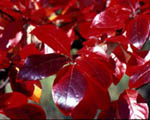Like bookends to the growing season, spring flowers and fall color frame the Piedmont summer. As the days shorten, chemical transformations are triggered in the vascular systems of deciduous trees. Nutrients flow down to the roots while the leaves, which fed the tree in summer but would be a liability in winter, are "abandoned". The changing color of the leaves signals the first stage of their eventual fall and decomposition.
 Whereas maples form the backbone of the renowned displays in a New England fall landscape, the color in central Virginia comes from a more diverse and sometimes subdued palette. Although large populations of Red Maples inhabit lowlands and some Sugar Maples grow naturally in higher elevations, other trees and shrubs tend to dominate the color scheme here. Earliest and, perhaps, most spectacular, is the intense, pure red of the Sour or Black Gum (Nyssa sylvatica). The White Ash (Fraxinus americana) is close behind with its beautifully bruised yellow and light purple leaves. Sweet Gum (Liquidambar styraciflua), which thrives in the wetlands of the eastern part of the county, provides a similarly complex and changing pattern, with leaves sometimes approaching a deep purple.
Whereas maples form the backbone of the renowned displays in a New England fall landscape, the color in central Virginia comes from a more diverse and sometimes subdued palette. Although large populations of Red Maples inhabit lowlands and some Sugar Maples grow naturally in higher elevations, other trees and shrubs tend to dominate the color scheme here. Earliest and, perhaps, most spectacular, is the intense, pure red of the Sour or Black Gum (Nyssa sylvatica). The White Ash (Fraxinus americana) is close behind with its beautifully bruised yellow and light purple leaves. Sweet Gum (Liquidambar styraciflua), which thrives in the wetlands of the eastern part of the county, provides a similarly complex and changing pattern, with leaves sometimes approaching a deep purple.
Sassafras (Sassafras albidum) and Sourwood (Oxydendrum arboreum) provide accents of orange and red, respectively, while shrubs such as Sumac (Rhus sp.) add notes of luminous red to the forest edge and to fence rows.
 Tulip Poplars, which form a majority of the trees in our area, provide a somewhat dull, yellow background to the other, showier species. However, oaks and hickories, which fill in the native stands of forest, can sometimes be as glorious as the usual "stars" of a Piedmont autumn. Scarlet and Red Oak (Quercus coccineus and Q. rubra) offer brilliant crimson tones, while, in some years, the hickories (Carya sp.) express a pure, rich yellow color. Eventually, all these leaves carpet the forest floor, decomposing to release their nutrients back into the soil and to provide a rich organic mulch for tree roots.
Tulip Poplars, which form a majority of the trees in our area, provide a somewhat dull, yellow background to the other, showier species. However, oaks and hickories, which fill in the native stands of forest, can sometimes be as glorious as the usual "stars" of a Piedmont autumn. Scarlet and Red Oak (Quercus coccineus and Q. rubra) offer brilliant crimson tones, while, in some years, the hickories (Carya sp.) express a pure, rich yellow color. Eventually, all these leaves carpet the forest floor, decomposing to release their nutrients back into the soil and to provide a rich organic mulch for tree roots.